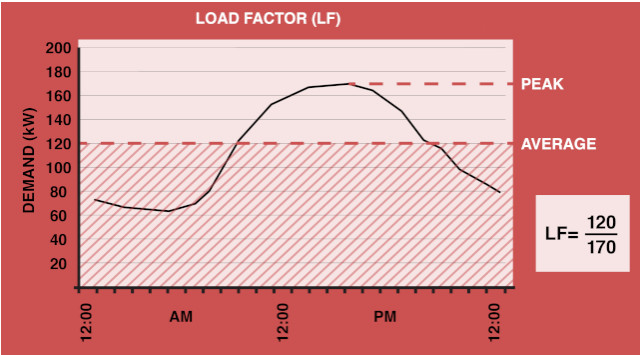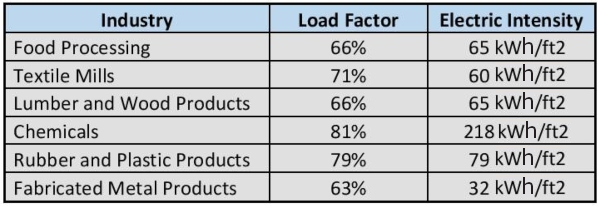Your energy costs consist of two parts — consumption and demand. High electrical loads strain the grid and demand charges help pay for the cost of providing more power. Demand is measured in short intervals; peak demand is your highest rate of electricity consumption during a given month. High peak demand can result in large demand charges on your monthly bill.
When planning for new facilities or an expansion, or even planning your budget, the question of peak demand often comes up. What will be the peak demand for this facility? The key to making this estimate is knowing the load factor for that industry segment, as well as the annual electric intensity (kWh/ft2).
Factoring your load
The load factor is an indicator of how steady your electrical load is over time. Load factor is a percentage figure that is calculated by dividing the average usage (kWAvg) over a billing cycle by the peak power demand (kWP). The higher the load factor, the more even the facility’s electric demand.
Load Factor = kWAvg/kWP = kWh/hrs ÷ kWP
In the following graph, the load factor is calculated to be 70%.
Load Factor = kWAvg/kWP = 120 kW ÷ 170 kW = 0.70

Using load factor to estimate peak demand
Oak Ridge National Laboratory has published load factors for a variety of industry segments based on data collected by Industrial Assessment Centers. A selection of these are shown in the table below, along with electric intensity data from the U.S. Department of Energy’s Manufacturing Energy Consumption Survey.

Using this data, let’s estimate the peak demand of a 10,000 ft2 plastics products facility by estimating its annual energy consumption and assuming an average load factor of 79%. We just solve for peak load (kWP).
Energy use (kWh) = 10,000 ft2 x 79 kWh/ft2 = 790,000 kWh
kWP= kWh/hrs ÷ Load Factor = 790,000 kWh/8,760 hr÷0.79 = 90.2/0.79 = 114 kW
These are very rough estimates. Hire a qualified professional engineer or use a facility energy simulation program for a more accurate calculation.
